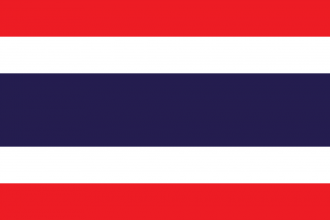The Kingdom of Thailand (widely referred to as “Thailand”) is a country of the Southeast Asia Indochinese peninsula, overlooking the Gulf of Thailand. The country shares land borders with Myanmar (Burma) to the North and West, with Laos to the East, with Cambodia to the South East and Malaysia to the South. Thailand is one of the most populated countries in the world, according to UN data (2015); specifically it is the 20th largest in terms of the number of its inhabitants, with some 68 million people. Bangkok, located in the central plain of the country, is the capital and largest city (with some 9.27 million people).
The country’s privileged location, has allowed Thailand to control the only land route of Malaysia and Singapore to the continent of Asia, while the country has never been occupied by another country. In fact, this geographic position has influenced Thailand in many ways; the diversity of its natural features and resources across its different regions - the mountainous North, the tourism, palm oil and rubber based economy to the South, the wet-rice rich agricultural central area, the touristic Southeast and the numerous dams and high mining activity to the West – have all contributed towards the creation of various cultural patterns, and social and economic development.
During the centuries, based on rice cultivation and commerce, many capitals succeeded one other along the Chao Phraya river, while Thai people were always looking for new ports of trade through the Gulf of Thailand and the Andaman sea (to the west).
During the last 20 years, Thailand has experienced remarkable economic growth, managing to reduce significantly the poverty rate, while joining in recent years the High Human Development group of countries, according to the UN’s annual Human Development Reports. The welfare, as a result of the Thailand’s economic growth, is multi-dimensionally expressed nowadays; millions of people have moved out of poverty –despite a significant 10.9% (2014) of the population still being considered as poor-, more children are educated, and the level of social security has grown. It is indicative that today, a 14.5% of General Government Expenditure, is spent on Health. According to the UN’s 2014 Human Development report though, Thailand still ranks low, standing at the 93rd position worldwide (by HDI rank), with an HDI (Human Development Index) value of 0.726. In addition, social inequalities still remain a challenge for the country, as Thailand’s Gini coefficient indicator was 37.85, in 2013.
Natural disasters in recent times have greatly affected the progress of Thai economic and social developments. In 2011, Thailand experienced the heaviest and most widespread rainfalls, resulting in the worst floods of the last 70 years. According to the Bank of Thailand (BOT), the floods had a very severe impact on businesses, especially the ones of the manufacturing sector (mainly automotive and electronics). Flooded factories and disruptions in the supply chain and transportation, higher production and delivery costs and even an instant increase in unemployment, were some of the significant impacts felt by the country. The production and sales recovery to normal levels, took from 3-6 months, for the majority of local businesses.
Despite the aforementioned, Thailand continues to be a prominent destination for tourists. Realising the significant contribution of tourism to the national GDP, Thailand revised its visa rules in 2015, towards the further promotion of the sector, therefore becoming the top destination for Chinese tourists.

